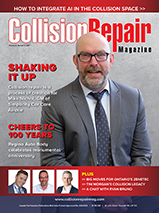The result, more efficient and profitable bodyshops and increased customer satisfaction. BETAG provides comprehensive technician and estimator training for both auto shops and OEM’s. The training is focused primarily onpanel repair, an area that occupies a large portion of collision repair work. Originally from Switzerland, the company has recently launched BETAG North America, after having operated the last 20 years internationally, including five years in the United States and Canada. The new initiative will create more opportunities for bodyshops and OEM’s to send their employees for training.
“I had the opportunity to spend the past week with Ralph and Andreas from BETAG Innovations learning small-medium panel repair and aluminum repair,” says Jim Wensel, technical trainer at Gerber Collision and Glass.“After being in the industry for over 30 years I never thought I would learn something new about metal work. I can say without a doubt after this week I will never look at a dent repair the same way again.”
BETAG’s technical training courses are broken down into two sides, front office and technician. On the front office side are estimator and estimator skills courses, which are both broken down into levels ranging between one and three. Introductory levels are designed to train those with little to no estimation experience and teach them how to write both a detailed and accurate estimate for all types of damages. The following levels expand on these skills and focus on teaching trainees how to explain the context of the estimations to customers.
On the technician side you can find courses in small damage, medium panel steel, medium panel aluminum and plastic repair. These courses teach workers how to properly and efficiently fix small damages, as well as provide technicians with OEM recommended techniques on how to produce high quality outer panel repairs. Technicians will use their teachings to test their skills on live vehicles.
The combination of both the training and equipment is how BETAG helps customers meet client expectations and produce overall higher quality work.
In addition to their training services, BETAG also manufactures tools and equipment for outer panel repair. Products including the T-Hotbox, Alu T-Hotbox and the Flatliner systems are ideal for removing dents and repairing damage to steel, aluminum and plastic panels.
BETAG Innovation
3750 University Ave. Ste 610 Riverside, CA 92501
1-347-686-9698 info@betaginnovation.com





















